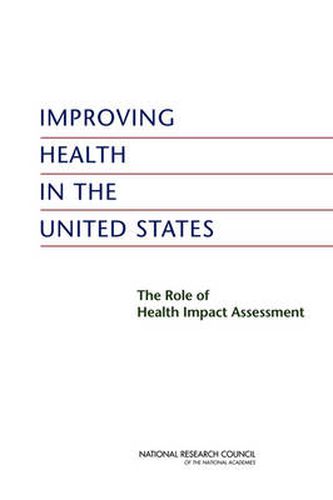Readings Newsletter
Become a Readings Member to make your shopping experience even easier.
Sign in or sign up for free!
You’re not far away from qualifying for FREE standard shipping within Australia
You’ve qualified for FREE standard shipping within Australia
The cart is loading…






Factoring health and related costs into decision making is essential to confronting the nation’s health problems and enhancing public well-being. Some policies and programs historically not recognized as relating to health are believed or known to have important health consequences. For example, public health has been linked to an array of policies that determine the quality and location of housing, availability of public transportation, land use and street connectivity, agricultural practices and the availability of various types of food, and development and location of businesses and industry. Improving Health in the United States: The Role of Health Impact Assessment offers guidance to officials in the public and private sectors on conducting HIAs to evaluate public health consequences of proposed decisions – such as those to build a major roadway, plan a city’s growth, or develop national agricultural policies – and suggests actions that could minimize adverse health impacts and optimize beneficial ones. Several approaches could be used to incorporate aspects of health into decision making, but HIA holds particular promise because of its applicability to a broad array of programs, consideration of both adverse and beneficial health effects, ability to consider and incorporate various types of evidence, and engagement of communities and stakeholders in a deliberative process. The report notes that HIA should not be assumed to be the best approach to every health policy question but rather should be seen as part of a spectrum of public health and policy-oriented approaches. The report presents a six-step framework for conducting HIA of proposed policies, programs, plans, and projects at federal, state, tribal, and local levels, including within the private sector. In addition, the report identifies several challenges to the successful use of HIA, such as balancing the need to provide timely information with the realities of varying data quality, producing quantitative estimates of health effects, and engaging stakeholders.
$9.00 standard shipping within Australia
FREE standard shipping within Australia for orders over $100.00
Express & International shipping calculated at checkout
Factoring health and related costs into decision making is essential to confronting the nation’s health problems and enhancing public well-being. Some policies and programs historically not recognized as relating to health are believed or known to have important health consequences. For example, public health has been linked to an array of policies that determine the quality and location of housing, availability of public transportation, land use and street connectivity, agricultural practices and the availability of various types of food, and development and location of businesses and industry. Improving Health in the United States: The Role of Health Impact Assessment offers guidance to officials in the public and private sectors on conducting HIAs to evaluate public health consequences of proposed decisions – such as those to build a major roadway, plan a city’s growth, or develop national agricultural policies – and suggests actions that could minimize adverse health impacts and optimize beneficial ones. Several approaches could be used to incorporate aspects of health into decision making, but HIA holds particular promise because of its applicability to a broad array of programs, consideration of both adverse and beneficial health effects, ability to consider and incorporate various types of evidence, and engagement of communities and stakeholders in a deliberative process. The report notes that HIA should not be assumed to be the best approach to every health policy question but rather should be seen as part of a spectrum of public health and policy-oriented approaches. The report presents a six-step framework for conducting HIA of proposed policies, programs, plans, and projects at federal, state, tribal, and local levels, including within the private sector. In addition, the report identifies several challenges to the successful use of HIA, such as balancing the need to provide timely information with the realities of varying data quality, producing quantitative estimates of health effects, and engaging stakeholders.